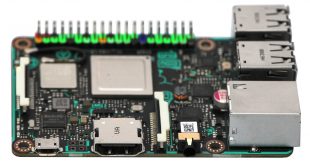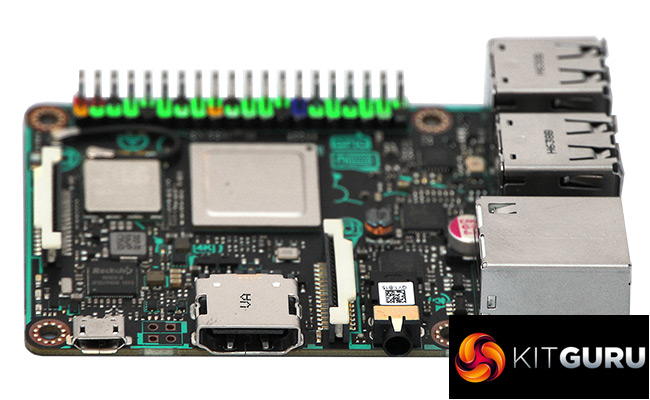
Maker culture has been going from strength to strength. The Arduino has been instrumental in this development, and the hugely successful Raspberry Pi has taken the revolution further with a full computing device for as little as £20. But these were just the beginning, and now ASUS is hoping to grab a bit of the action with its Tinker Board.
Where the Arduino, and its derivatives such as the Intel Genuino 101, are essentially control co-processors primarily designed to work with sensors, inputs, and outputs, the ASUS Tinker Board has much more in common with the Raspberry Pi. It's a complete computer, and can run a full operating system including Linux and Android, although not Windows 10, unlike the more recent spins of the Pi.
One of the Tinker Board's secret weapons is its CPU. The tiny little computer is based around a Rockchip RK3288, which incorporates a 1.8GHz quad-core Arm Cortex-A17 processor. The latest Raspberry Pi 3 only uses a 1.2GHz ARM Cortex-A53 quad-core CPU, although the latter is a more recent generation (ARMv8-A rather than ARMv7-A). The Tinker Board has more, and faster memory as well. Where the Pi 3 has 1GB of 900MHz DDR2, the ASUS alternative sports 2GB of dual-channel DDR3, although ASUS doesn't state the speed.
The GPU acceleration comes in the form of a 600MHz Mali-T764, which supports up to OpenGL ES 3.1, OpenCL 1.1, RenderScript and Direct3D 11.1. It's also capable of display outputs up to 3,840 x 2,160 and can decode H.264 in 1080p and 4K, as well as H.265 4K video. The Broadcom VideoCore IV in the Raspberry Pi 3 runs at 300MHz, only supports OpenGL ES 2.0, and has a maximum resolution of 1,080p.
There are some other differences, too. The Pi 3 has 100Mbit Ethernet, whereas the Tinker Board boasts Gigabit Ethernet. However, both offer just 802.11n WiFi not 802.11ac, four USB 2.0 ports rather than USB 3.0, HDMI video output, an audio minijack, a 40-pin IO header, and two 15-pin serial interfaces, one for camera (CSI) and one for display (DSI). The Pi 3 has Bluetooth 4.1 but the Tinker Board Bluetooth 4.0.
So ASUS is trying to match the Raspberry Pi 3 for connectivity and peripheral compatibility, whilst trumping it on the performance of the underlying hardware. However, the Tinker Board is quite a bit more expensive than the Raspberry Pi 3 – £46.99 versus £31.19 at the time of writing (inc VAT). Let's find out if it's worth the 50 per cent extra outlay.
Features:
- Rockchip RK3288 procesor
- 1.8GHz ARM Cortex-A17 quad-core CPU
- 600MHz ARM Mali-T764 quad-core GPU
- Realtek ALC4040 audio codec
- 2GB dual-channel DDR3 memory
- MicroSD card slot
- HDMI
- Gigabit Ethernet LAN
- 802.11b/g/n WLAN, Bluetooth 4.0
- 4 x USB 2.0
- Combi audio minijack – headphone/line output and microphone output
- 40-pin GPIO header
- 15-pin DSI
- 15-pin CSI
Price (at the time of writing): £46.99 (inc. VAT)
 KitGuru KitGuru.net – Tech News | Hardware News | Hardware Reviews | IOS | Mobile | Gaming | Graphics Cards
KitGuru KitGuru.net – Tech News | Hardware News | Hardware Reviews | IOS | Mobile | Gaming | Graphics Cards




Arrr… Raspberry Pi 3 top result compared https://browser.geekbench.com/v4/cpu/compare/3061317?baseline=5408809 Not best result for RK3288. Google’s OP1 actually RK3288 also https://browser.geekbench.com/v4/cpu/compare/5060917?baseline=5408809 better performance… Ho… Ho…
See https://www.ossblog.org/installing-google-play-store-asus-tinker-board/ , where Steve Emms published an article on performing the Googleplay installation back in May 2017 (well over 7 months ago now, back about 2 months after I first received my Tinkerboard).
The only real problem I’ve found with the Tinkerboard, from the perspective of a system developer, is that the Android image is not certified properly to allow it to use HDCP, which negates it’s ability to run apps that use HDMI copy-protection on hardware that doesn’t support it –such as Comcast’s Xfinity app, used to watch cable channels over IP.
Everything else I’ve ran on this board, under Android, has been blazing fast –including Kodi 17.6.
I took a good long look over Asus’s release of Debian (called TinkerOS), and realized very quickly that their in-house Linux dev team were clueless about making a solid Linux. I replaced that install with Armbian and it worked beautifully. There were no real issues worth mentioning –at least not anything that the average Linux user would be surprised by or have any trouble working around.
I’ve kept my Tinkerboard running on Android, with Googleplay, Youtube, and several other GAPPS automatically updating correctly since May 20th when I did the final build for my board. Since I launched that system, it’s been paired with a 23″ Dell touch screen (w/ 10-pt multitouch), and works for us like a giant tablet. Its roughly twice the speed of the RPi3 on just CPU/ram-speed alone, and combined with Gbit eth0, this is one of the fastest ARM based boards I’ve ever used.
Personally, I’d recommend this board to anyone with the experience to know what to do with it. For those that aren’t quite there yet, spend more time with RPI3 boards and Linux on x86/x64; this will help you gain the troubleshooting skills you’ll need for working with these sorts of environments.
Right now, the Tinkerboard is my personal board of choice for high speed embedded projects, but I’m not depending on Asus to supply me with OS code, so that may make quite a bit of difference in my case –but really, that’s how RPi boards are too… the best OS image releases tend to be 3rd party images, or the ones built by experts for their own projects. In terms of real world performance (rather than artificial results generated from simulated workloads), I’ve had no issues with mine at all.
Oh, and Eleduino makes some great all-aluminum cases that fit both Tinkerboard and RPi2/3; I nailed down 3 of them, and used 1 of the 2 I ordered in Piano-black for my Tinkerboard. Surprisingly, the black cases were cheaper ($13) compared to the anodized (silver) aluminum models by $5 ($18 for the silver cases), but they worked interchangeably and shed heat like a big heatsink so I’ve needed no fans at all.
That was an awesome review. Thank you.
Thanks for your detailed comment! I did try the Emms Google Play install, but it didn’t work. Not sure what I was doing wrong. It actually completely borked my Android install so I had to revert to the original image again.
Seems the Android version makes a big difference.
It *wasn’t* an easy process, at all. But I think in that original discussion I’d posted, there were notes further down that allude to the debugging work we did to get it working right on a single installation run. I’m at work now, but I’ll be home soon… and will try to remember to look over that info, gather it together into a concise document and publish it somewhere as a howto.